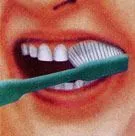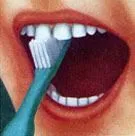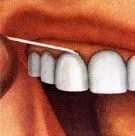At the office of Mark A. Barradas, D.D.S., we like to make sure our patients have the information they need for all things dentistry. For information on all of your dental health needs, please visit the American Dental Association's website by clicking the image below:
Brushing Basics
Brushing removes food and plaque – the sticky, nearly colorless film of bacteria that forms on teeth and is the main cause of decay and gum disease.
- Brush at least twice a day with a fluoride toothpaste that has the American Dental Association (ADA) seal of acceptance. The seal means that research has proven the product's safety and effectiveness and that advertising and packaging claims were found to be accurate by the ADA.
- Use a toothbrush with soft, rounded bristles and replace it every three months or when bristles show wear.

To clean the outer surfaces of your teeth, tilt the brush at a 45-degree angle against the gum line. Gently move the brush in small circular strokes. Keep the bristles angled against the gum line.

Repeat the motion on the inside surfaces of your teeth.

Brush the chewing surfaces using small circular strokes.

To clean the inner surfaces of your front teeth, hold the brush vertically and use gentle up-and-down strokes with the front part of the brush.

Gently brush your tongue to remove bacteria and to freshen breath.
- Waxed and unwaxed flosses are both effective, use whichever you prefer.
- To make sure you floss all your teeth, start behind the upper molars at one side of your mouth and work to the other side. Repeat on the lower teeth.
- If you have trouble manipulating floss, ask your dentist or hygienist about interdental cleaners, which also remove plaque from between your teeth.

Break off about 18 inches of floss and wind most of it around one middle finger. Wind the rest around the middle finger of your other hand.

Using your thumbs and forefingers, slide about an inch of taut floss between your teeth. Gently curve the floss around the tooth in a C-shape at the gum line

Slide the floss gently up and down between the tooth and gum, making sure you go beneath the gum line Repeat on the rest of your teeth with clean sections of floss./p>
Dental Do's and Don'ts
Do see your dentist at least every six months for a general checkup and cleaning.
Don't bite pens, chew ice or other hard items like popcorn kernels, or use your teeth as tools. These habits can chip a tooth's enamel or crack the tooth itself. They may also damage fillings, crowns, or other restorations.
Do wear a mouthguard when you play sports. Professional athletes wear mouthguards to protect their teeth from injury, and so should you.
Don't smoke or chew tobacco. Besides staining the teeth, tobacco contributes to gum disease and can cause oral cancer.
Do watch how much coffee and tea you drink. Excessive amounts can stain your teeth.
Don't grind or clench your teeth. Many adults take out stress on their jaws and teeth without realizing it. This habit is called bruxism and can seriously damage and wear down your teeth. Consult your dentist if you notice any of these warning signs: pain when chewing, a tired jaw when you wake up, and unexplained headaches. He or she may suggest that you wear a custom-made mouthguard at night or may prescribe other treatments.
Do get enough fluoride. Adults as well as children benefit from fluoride to help prevent decay. Ask your dentist how to get the proper amount. Common sources: fluoridated water; toothpastes and rinses (make sure they have the American Dental Association seal of acceptance); professional topical treatments; or prescription drops, gels, or tablets.
Do watch for early warning signs of oral cancer and ask your dentist how to do self-exams at home. Most oral cancers can be cured if caught early. Be on the lookout for abnormal growths; white or velvety red patches in the mouth; persistent sores or swelling; repeated bleeding; or a numb or painful area. You can also reduce your risk by avoiding tobacco and prolonged exposure to the sun; eating a balanced diet; consuming alcohol in moderation; and practicing good oral hygiene.
Common Questions
What is tartar?
Tartar (or calculus) is yellow or brown crusty, mineralized plaque. It can contribute to gum disease and can be removed only by a dental professional.
I've never had a cavity. So why do I need regular checkups?
Dentists check for more than decay during exams. They look for early signs of gum disease, oral cancer, and other problems.
Are X-rays necessary?
X-rays reveal problems that dentists can't see with the naked eye, such as decay between teeth or damage to the bone caused by gum disease. Early detection of these and other problems can prevent extensive damage and avoid expensive treatments. Your dentist will decide how often you need X-rays and will protect you with leaded aprons that help reduce the radiation to which you're exposed to negligible amounts. Digital X-rays reduce exposure by 50 to 90% over film. If you're pregnant or think you may be, tell your dentist or hygienist. X-rays can possibly be delayed until after the baby is born.
What should I do if I chip a tooth or one is knocked out?
If a tooth is chipped, clean the injured tooth with warm water. See your dentist as soon as possible and take any broken pieces; he or she may be able to bond them back onto the tooth. If a tooth is knocked out, pick it up by the crown (or top), not the more delicate root, and rinse it off. Then place the tooth in milk, or wrap it in a damp cloth. If you get to the dentist within a half-hour, there's a 90 percent chance that the tooth can be replanted.
Will my mouth change as I get older?
Your oral tissues do change as you age. Some common problems:
- Dry mouth. Medications such as antihistamines, decongestants, painkillers, and diuretics can cause dry mouth, which increases your risk of cavities because it reduces the saliva that washes away bacteria. Your dentist may suggest such treatments as artificial saliva or sugar-free candy to stimulate saliva.
- Root caries. Your gums often recede as you age, exposing the root and making root caries (or root decay) more likely. Root carries also can make teeth more sensitive. Your dentist may prescribe fluoride therapy and tell you to avoid sugary foods and drinks.
- Darkening teeth. This is a natural process as you age. Ask your dentist about bleaching, which may be able to lighten the teeth.
My child just got braces. Is it too late for me?
Your teeth may take longer to move than your child's, but orthodontic treatment can be just as effective. In fact, more than one out of four patients receiving orthodontic treatment is an adult. And today, braces are smaller, more comfortable, and less noticeable.

